A Comparative Analysis of Soft Switching Techniques in Reducing the Energy Loss and Improving the Soft Switching Range in Power Converters
Abstract
:1. Introduction
2. Analysis of the Soft Switching Modes for Energy Loss Measurement
2.1. The Hard Switching Mode
2.2. The Zero-Voltage Switching Mode (ZVS)
2.3. The Zero-Current Switching Mode
2.4. The True Zero-Voltage Zero-Current Switching
3. Analysis for the Estimation of the Soft Switching Range
3.1. The Zero-Voltage Switching (ZVS)
3.2. The Zero-Current Switching (ZCS)
3.3. The True Zero-Voltage Zero-Current Switching
4. Simulation Results for Comparative Analysis
5. Experimental Verification
5.1. Converter Topology and PWM Switching
- Stage 1: the ZVZCS mode;
- Stage 2: the ZVS mode;
- Stage 3: the ZCS mode;
- Stage 4: the hard switching (HS) mode.
5.2. Converter Operational Intervals
- (a)
- Interval 1 [t1 − t0, Stage 1 + Stage 2]:
- (b)
- Interval 2 [t2 − t1, Stage 1+ Stage 2]:
- (c)
- Interval 3 [t3 − t2, Stage 1 + Stage 3]:
- (d)
- Interval 4 [t4 − t3, Stage 1–4]:
- (e)
- Interval 5 [t5 − t4, Stage 1–4]:
- (f)
- Interval 6 [t6 − t5, Stage 1–4]:
- (g)
- Interval 7 [t8 − t7, Stage 1–4]:
5.3. Experimental Setup
5.4. Results and Discussion
6. Conclusions
Author Contributions
Funding
Conflicts of Interest
References
- Chien-Ming, W. A New Family of Zero-Current-Switching (ZCS) PWM Converters. IEEE Trans. Ind. Electron. 2005, 52, 1117–1125. [Google Scholar] [CrossRef]
- Mohammadi, M.; Adib, E.; Yazdani, M.R. Family of Soft-Switching Single-Switch PWM Converters With Lossless Passive Snubber. IEEE Trans. Ind. Electron. 2015, 62, 3473–3481. [Google Scholar] [CrossRef]
- Mohammadi, M.R.; Farzanehfard, H. A New Family of Zero-Voltage-Transition Nonisolated Bidirectional Converters With Simple Auxiliary Circuit. IEEE Trans. Ind. Electron. 2016, 63, 1519–1527. [Google Scholar] [CrossRef]
- Dusmez, S.; Khaligh, A.; Hasanzadeh, A. A Zero-Voltage-Transition Bidirectional DC/DC Converter. Ind. Electron. IEEE Trans. 2015, 62, 3152–3162. [Google Scholar] [CrossRef]
- Mishima, T.; Nakaoka, M. A Practical ZCS-PWM Boost DC-DC Converter With Clamping Diode-Assisted Active Edge-Resonant Cell and Its Extended Topologies. IEEE Trans. Ind. Electron. 2013, 60, 2225–2236. [Google Scholar] [CrossRef]
- Zhang, J.; Lai, J.-S.; Kim, R.-Y.; Yu, W. High-power density design of a soft-switching high-power bidirectional dc–dc converter. Power Electron. IEEE Trans. 2007, 22, 1145–1153. [Google Scholar] [CrossRef]
- Ashique, R.H.; Salam, Z.; Aziz, M.J.A. A high power density soft switching bidirectional converter using unified resonant circuit. In Proceedings of the 2015 IEEE Conference on Energy Conversion (CENCON), Johor Bahru, Malaysia, 19–20 October 2015; pp. 165–170. [Google Scholar]
- Han, D.-W.; Lee, H.-J.; Shin, S.-C.; Kim, J.-G.; Jung, Y.-C.; Won, C.-Y. A new soft switching ZVT boost converter using auxiliary resonant circuit. In Proceedings of the 2012 IEEE Conference on Vehicle Power and Propulsion Conference (VPPC), Seoul, Korea, 9–12 October 2012; pp. 1250–1255. [Google Scholar]
- Ivanovic, B.; Stojiljkovic, Z. A novel active soft switching snubber designed for boost converter. IEEE Trans. Power Electron. 2004, 19, 658–665. [Google Scholar] [CrossRef]
- Mishima, T.; Nakaoka, M. A new family of soft switching PWM non-isolated DC-DC converters with Active auxiliary Edge-Resonant Cell. In Proceedings of the 2010 International Power Electronics Conference (IPEC), Sapporo, Japan, 21–24 June 2010; pp. 2804–2809. [Google Scholar]
- Patil, D.; Rathore, A.K.; Srinivasan, D. A non-isolated bidirectional soft switching current fed LCL resonant dc/dc converter to interface energy storage in DC microgrid. In Proceedings of the 2015 IEEE Applied Power Electronics Conference and Exposition (APEC), Charlotte, NC, USA, 15–9 March 2015; pp. 709–716. [Google Scholar]
- Rathore, A.K.; Patil, D.R.; Srinivasan, D. A Non-Isolated Bidirectional Soft Switching Current fed LCL Resonant DC/DC Converter to Interface Energy Storage in DC Microgrid. Ind. Appl. IEEE Trans. 2015, 52, 1711–1722. [Google Scholar] [CrossRef]
- Ahmadi, M.; Mohammadi, M.R.; Adib, E.; Farzanehfard, H. Family of non-isolated zero current transition bi-directional converters with one auxiliary switch. IET Power Electron. 2012, 5, 158–165. [Google Scholar] [CrossRef]
- Ardi, H.; Ahrabi, R.R.; Ravadanegh, S.N. Non-isolated bidirectional DC–DC converter analysis and implementation. IET Power Electron. 2014, 7, 3033–3044. [Google Scholar] [CrossRef]
- Sanchis-Kilders, E.; Ferreres, A.; Maset, E.; Ejea, J.B.; Esteve, V.; Jordan, J.; Calvente, J.; Garrigos, A. Bidirectional high-power high-efficiency non-isolated step-up dc-dc converter. In Proceedings of the 37th IEEE Power Electronics Specialists Conference, Jeju, Korea, 18–22 June 2006; pp. 1–7. [Google Scholar]
- Akin, B. An Improved ZVT–ZCT PWM DC–DC Boost Converter With Increased Efficiency. Power Electron. IEEE Trans. 2014, 29, 1919–1926. [Google Scholar] [CrossRef]
- Aksoy, I.; Bodur, H.; Bakan, A.F. A New ZVT-ZCT-PWM DC–DC Converter. IEEE Trans. Power Electron. 2010, 25, 2093–2105. [Google Scholar] [CrossRef]
- Bodur, H.; Bakan, A.F. A new ZVT-ZCT-PWM DC-DC converter. Power Electron. IEEE Trans. 2004, 19, 676–684. [Google Scholar] [CrossRef]
- Ashique, R.H.; Shihavuddin, A.S.M.; Khan, M.M.; Islam, A.; Ahmed, J.; Arif, M.; Maruf, M.H.; Mansur, A.A.; Haq, M.A.U.; Siddiquee, A. An Analysis and Modeling of the Class-E Inverter for ZVS/ZVDS at Any Duty Ratio with High Input Ripple Current. Electronics 2021, 10, 1312. [Google Scholar] [CrossRef]
- De Oliveira Stein, C.M.; Hey, H.L. A true ZCZVT commutation cell for PWM converters. Power Electron. IEEE Trans. 2000, 15, 185–193. [Google Scholar] [CrossRef] [Green Version]
- Urgun, S. Zero-voltage transition–zero-current transition pulsewidth modulation DC–DC buck converter with zero-voltage switching–zero-current switching auxiliary circuit. Power Electron. IET 2012, 5, 627–634. [Google Scholar] [CrossRef]
- Ashique, R.H.; Salam, Z. A Family of True Zero Voltage Zero Current Switching (ZVZCS) Non-isolated Bidirectional DC-DC Converter with Wide Soft Switching Range. IEEE Trans. Ind. Electron. 2017, 64, 5416–5427. [Google Scholar] [CrossRef]
- Stein, C.D.O.; Hey, H.L. A true ZCZVT commutation cell for PWM converters. In Proceedings of the APEC’98 Thirteenth Annual Applied Power Electronics Conference and Exposition, Anaheim, CA, USA, 15–19 February 1998; pp. 1070–1076. [Google Scholar]
- Mohammad, K.; Ahad, A.; bin Arif, M.S.; Ashique, R.H. Critical Analysis and Performance Evaluation of Solar PV-System Implementing Non-Isolated DC-DC Converters. In Proceedings of the 2021 3rd International Conference on Sustainable Technologies for Industry 4.0 (STI), IEEE, Dhaka, Bangladesh, 18–19 December 2021; pp. 1–6. [Google Scholar]
- Ashique, R.H.; Maruf, M.H.; Sourov, K.M.S.H.; Islam, M.M.; Islam, A.; Rabbani, M.; Islam, R.M.; Khan, M.M.; Shihavuddin, A.S.M. A Comparative Performance Analysis of Zero Voltage Switching Class E and Selected Enhanced Class E Inverters. Electronics 2021, 10, 2226. [Google Scholar] [CrossRef]
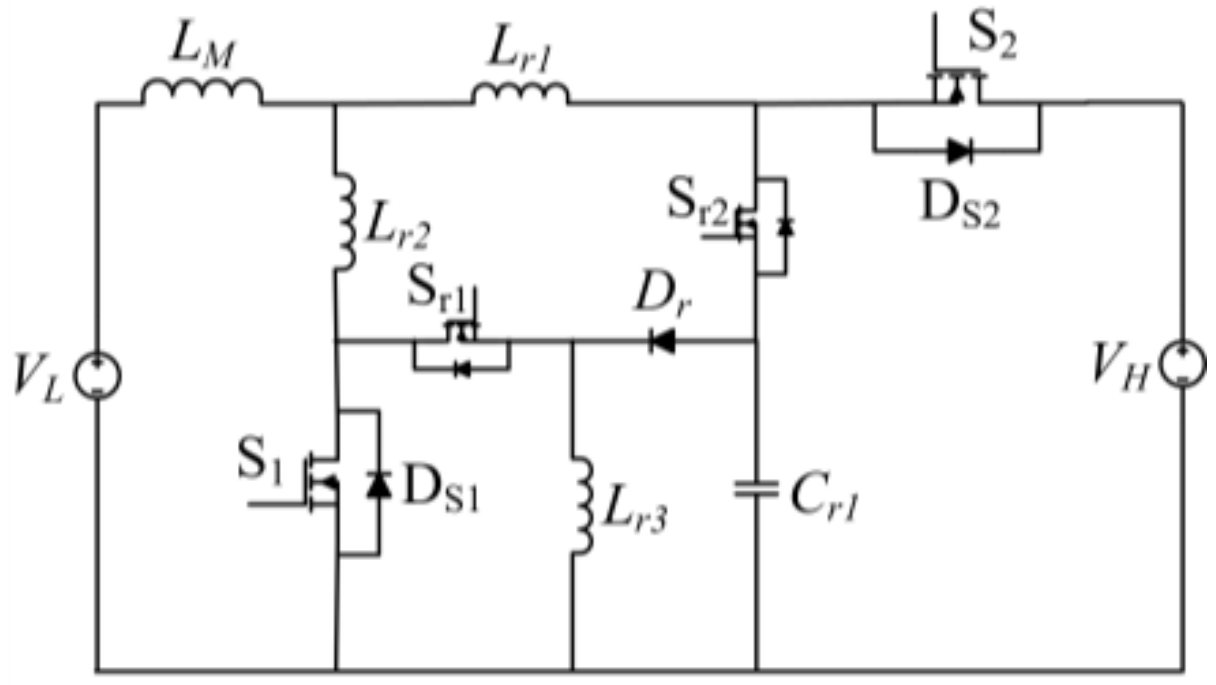

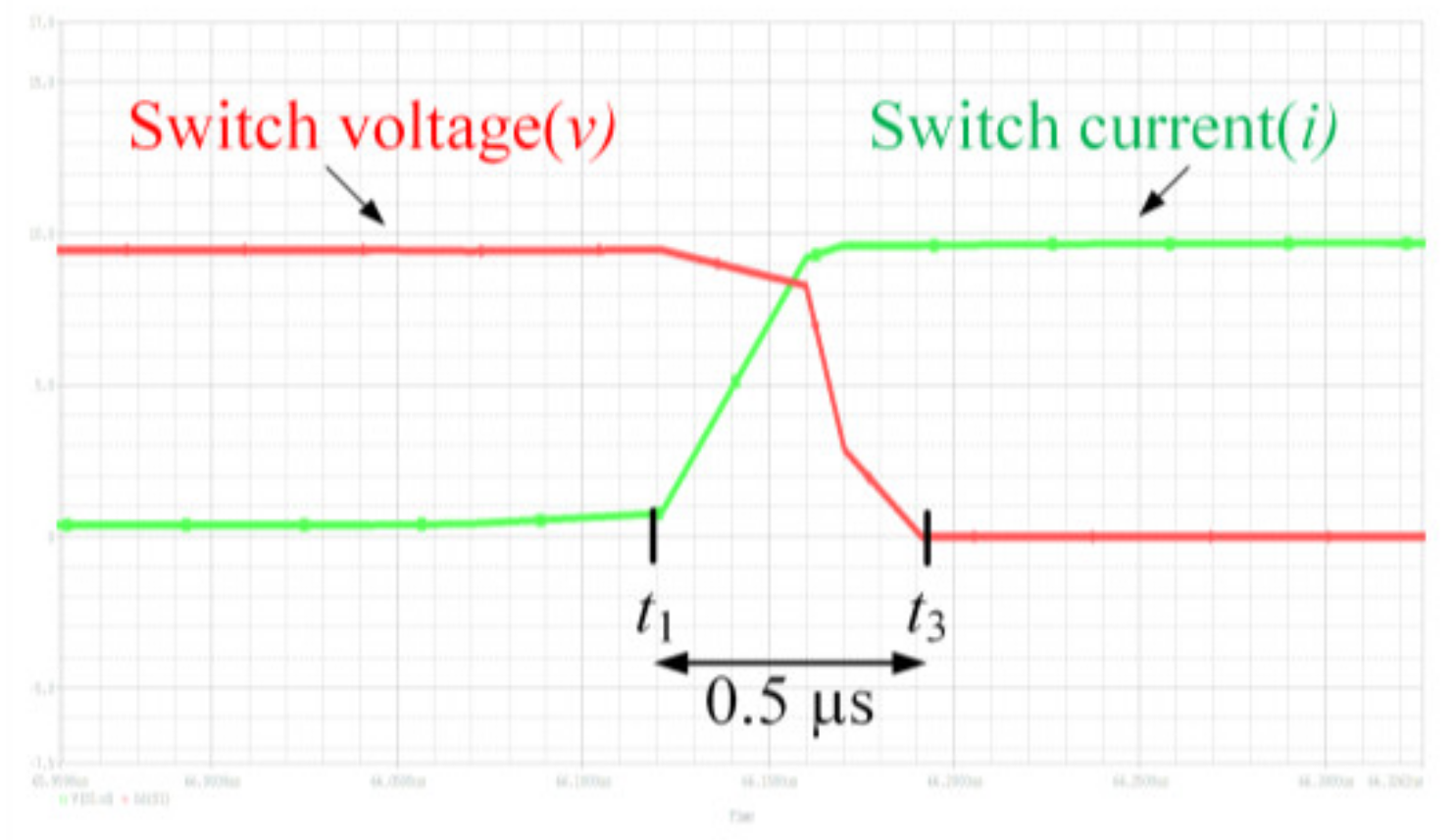
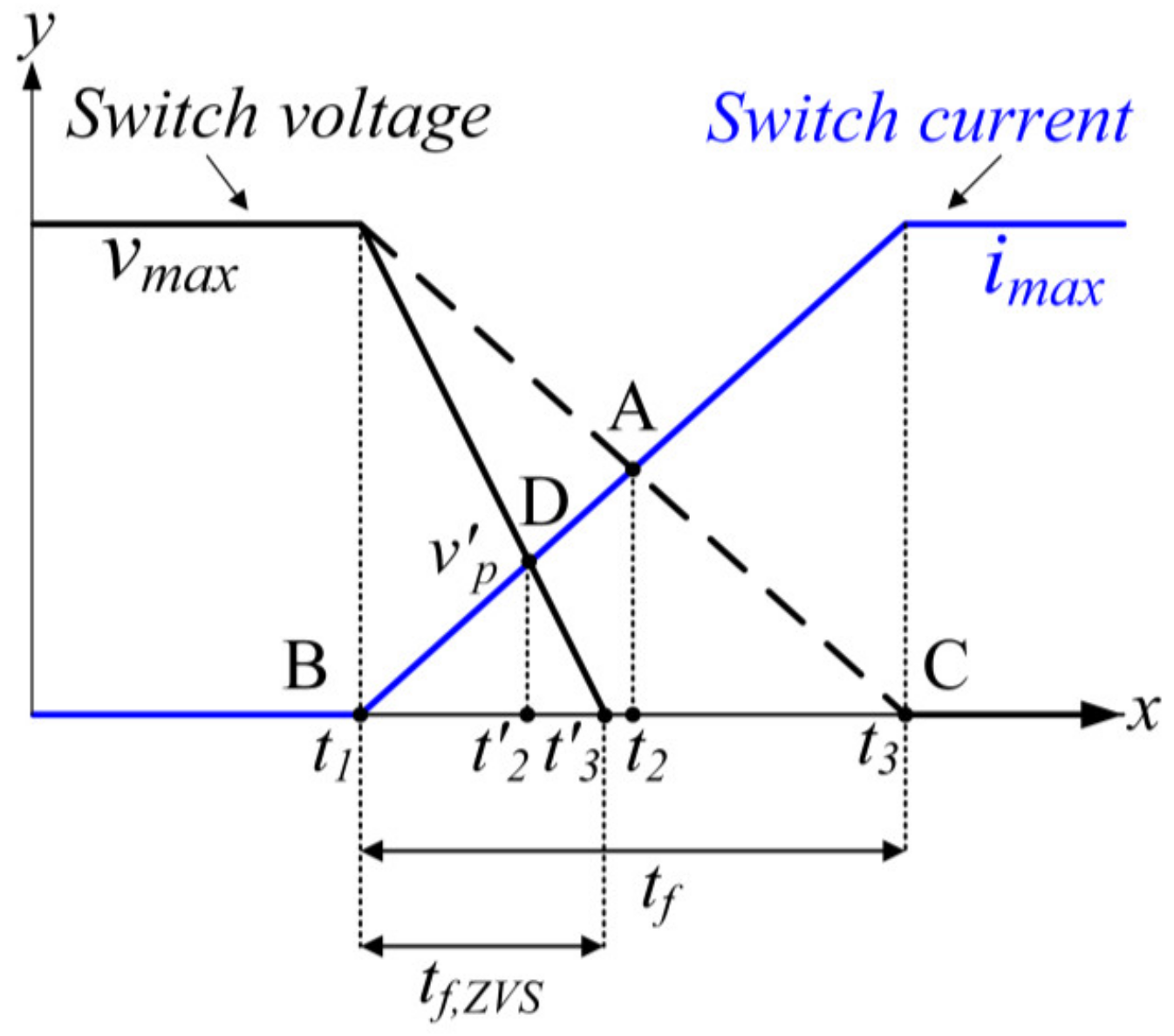

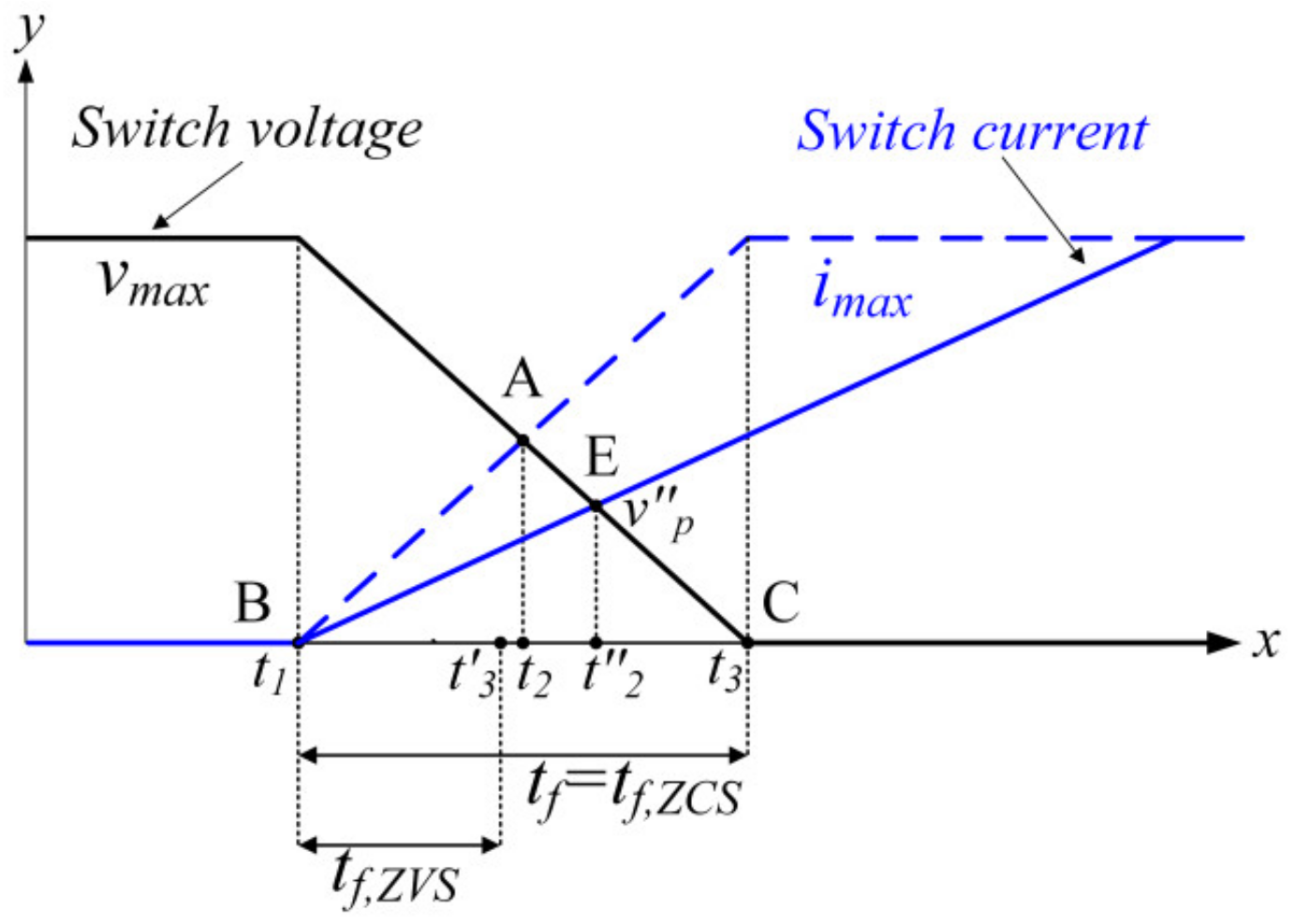
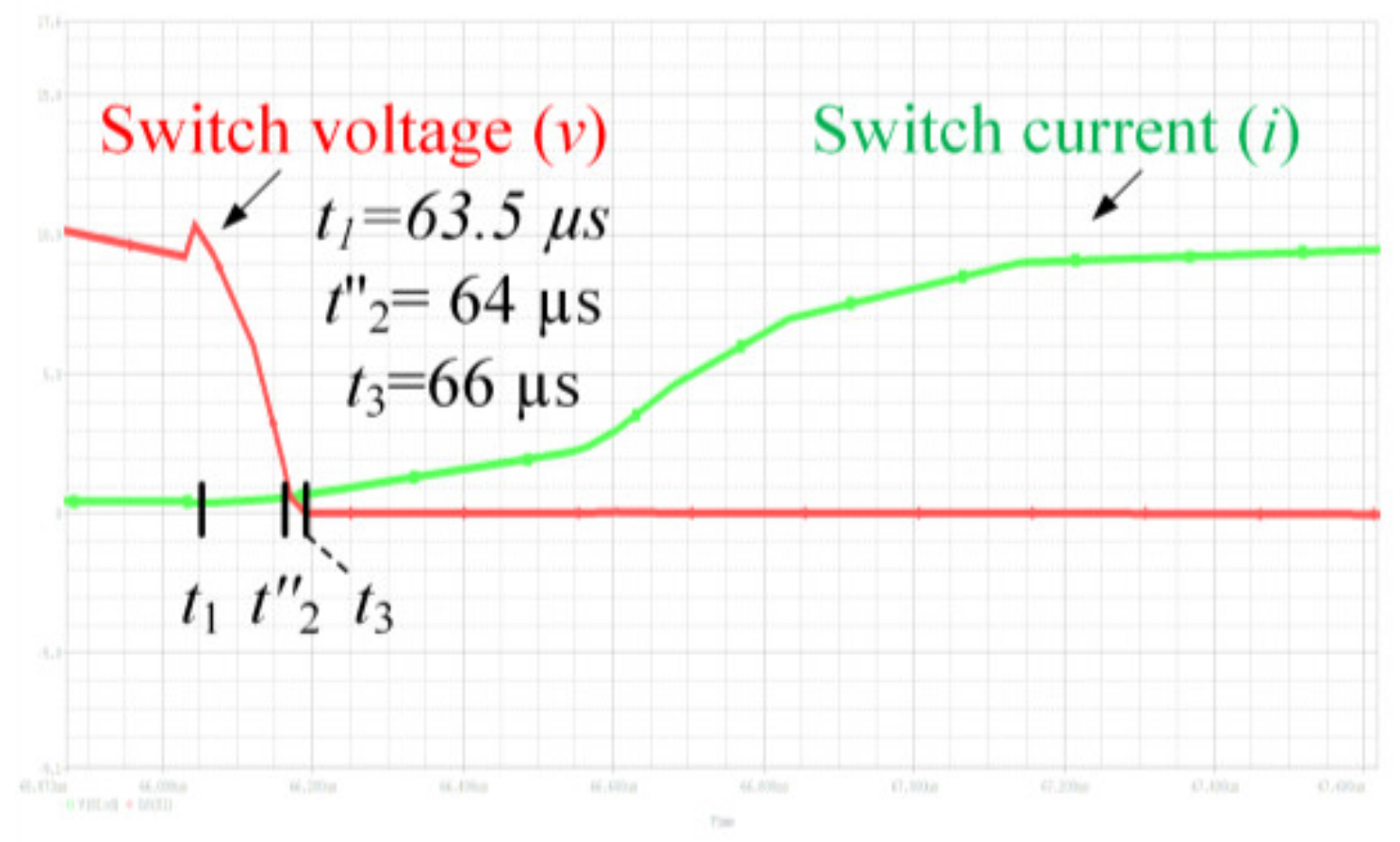
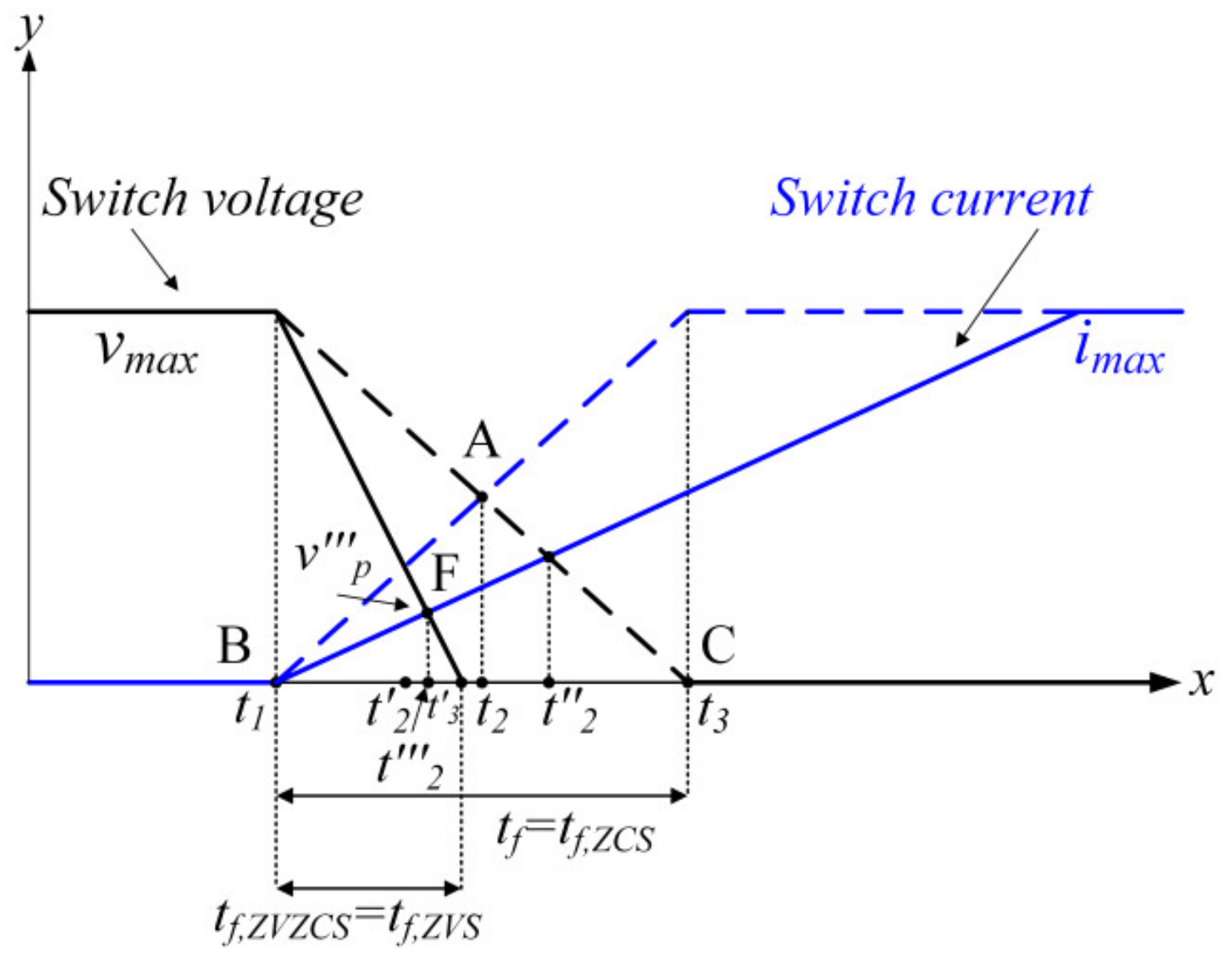




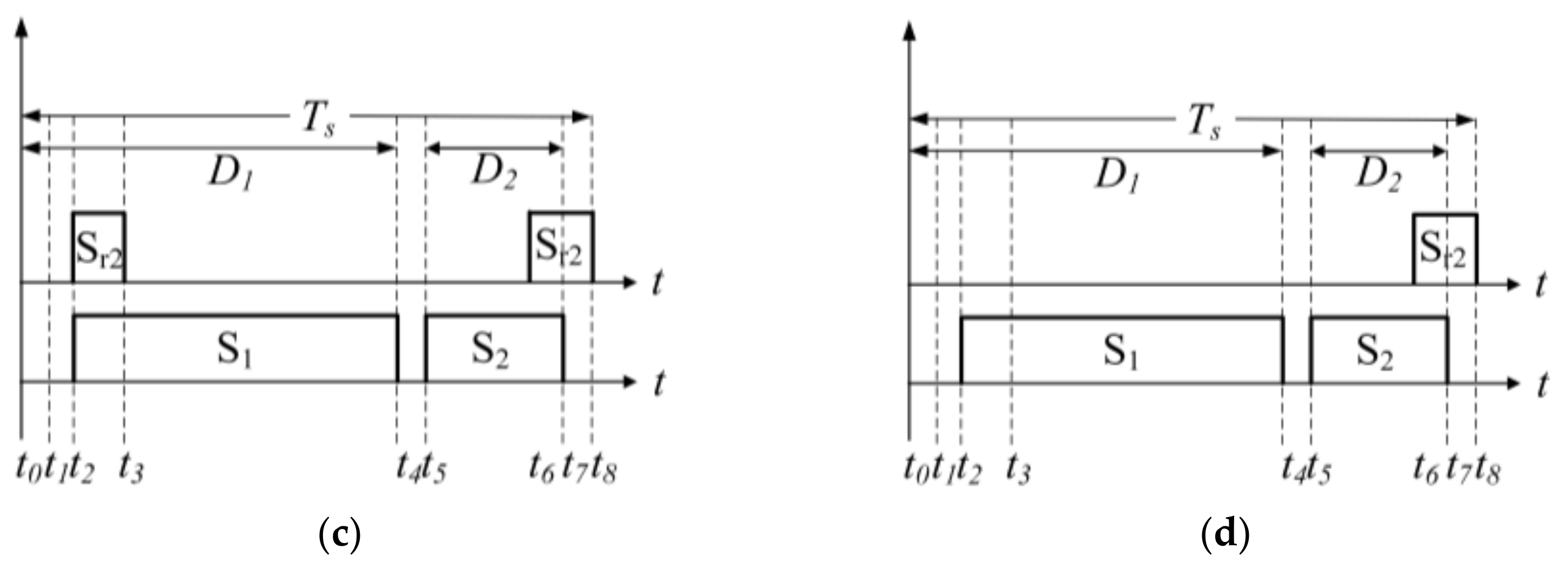

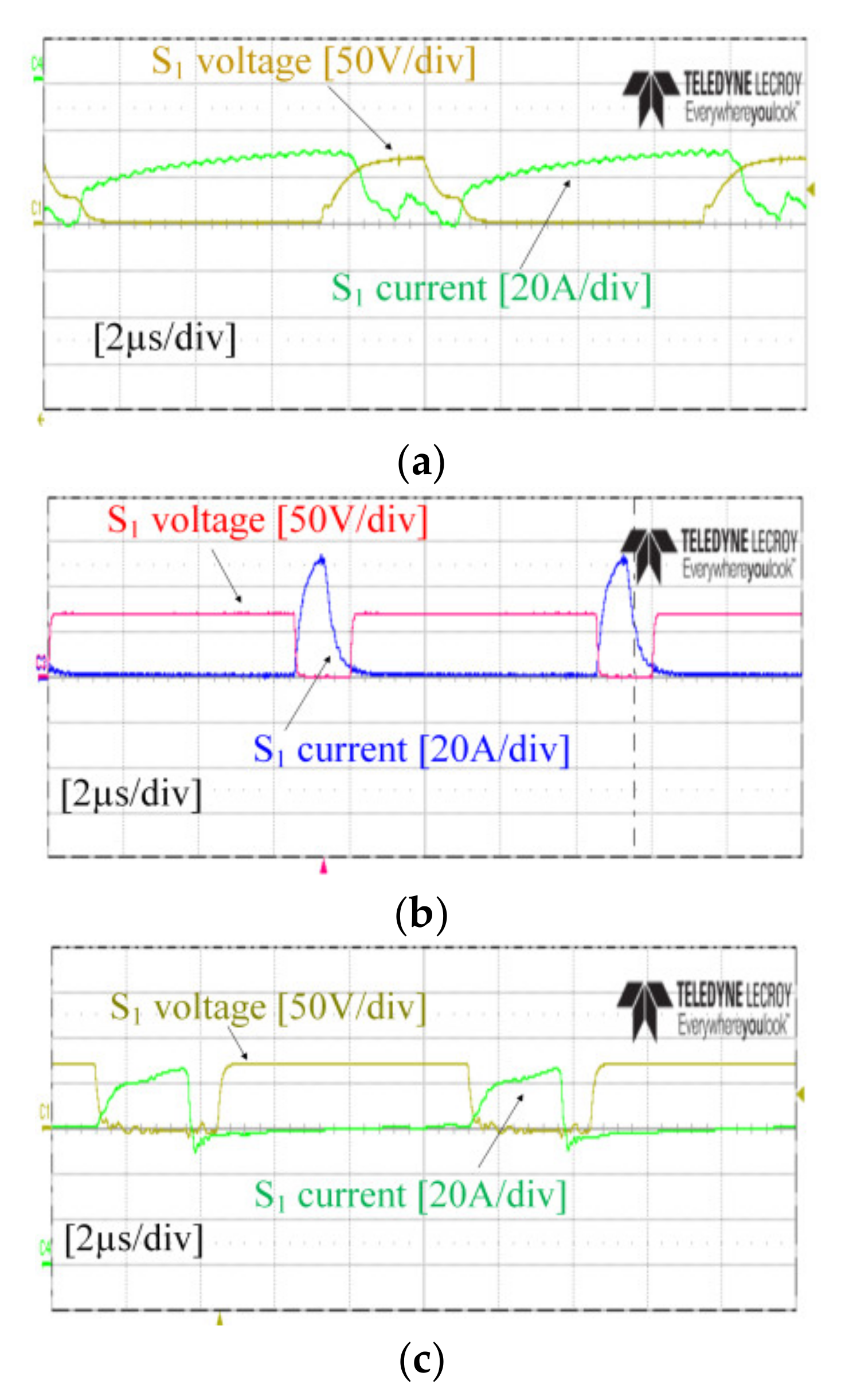

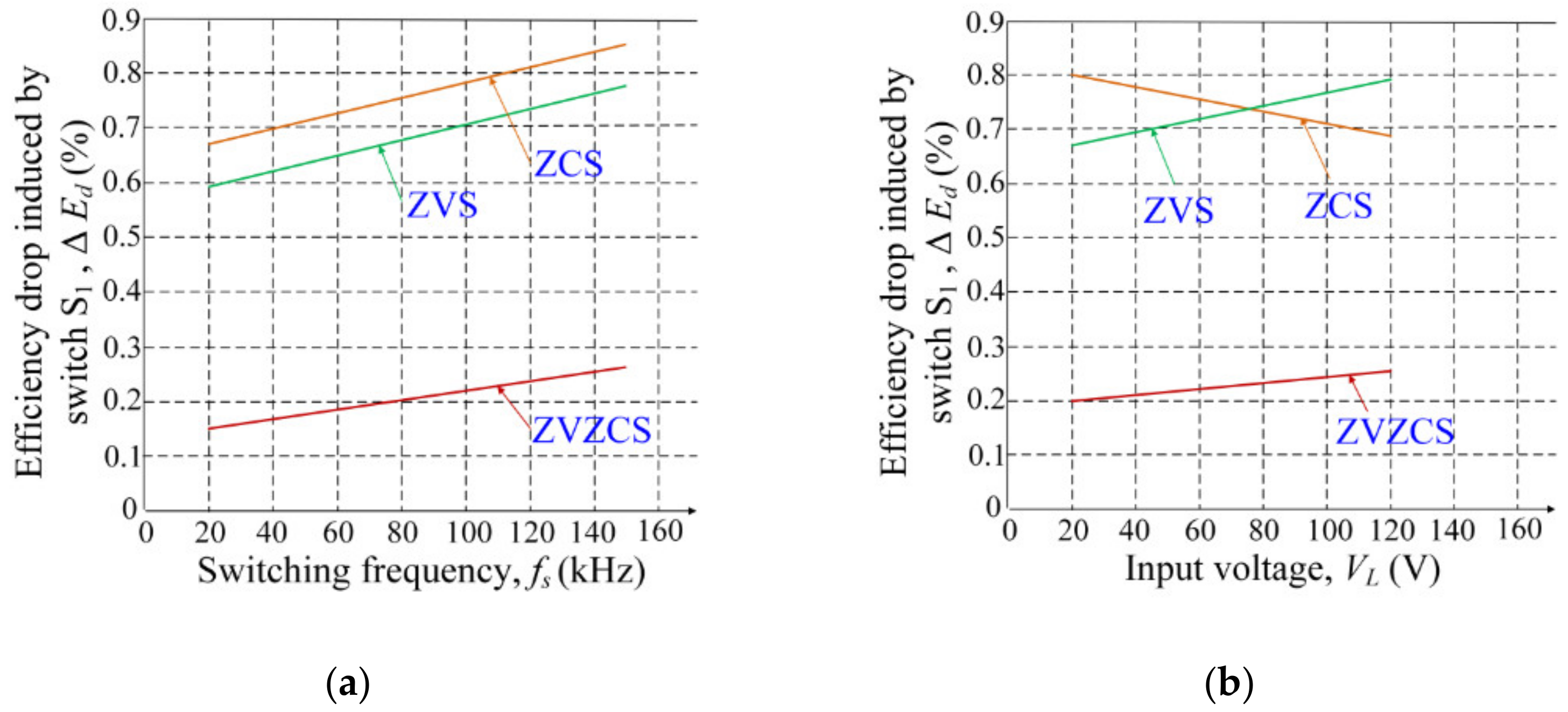
| Parameter | Value/Model |
|---|---|
| Mode of operation | Boost |
| POUT | 200 W |
| LM | 500 µH |
| fs | 100 kHz |
| VL | 50 V |
| VH | 100 V |
| Lr1, Lr2 | 0.47 µH |
| Lr3 | 0.10 µH |
| Cr1 | 100 µF |
| CL, CH | 470 µF |
| Parameter | Value/Model |
|---|---|
| Mode of operation | Boost |
| POUT | 200 W |
| LM | 500 µH |
| All switches | MOSFET IRF150 |
| State A: fS = 50 kHz, POUT = 200 W, VL = 50 V | ||||
|---|---|---|---|---|
| Refs. for Simulated Topology | Soft Switching Mode | Loss (mW) | ||
| Turn On | Turn Off | Turn On | Turn Off | |
| [4] | ZVS | ZVS | 1200 | 500 |
| [6] | ZVS | ZVS | 1400 | 650 |
| [3] | ZVS | ZVS | 1150 | 520 |
| [1] | ZCS | ZCS | 1480 | 780 |
| [5] | ZCS | ZCS | 1450 | 745 |
| [13] | ZCS | ZCS | 1440 | 745 |
| [2] | ZCS | ZVS | 1390 | 540 |
| [23] | ZVZCS | ZVZCS | 950 | 520 |
| [24] | ZVZCS | ZVZCS | 850 | 440 |
| [25] | ZVZCS | ZVZCS | 820 | 410 |
| State B: fS = 50 kHz, POUT = 200 W, VL = 100 V | ||||
| [4] | ZVS | ZVS | 1350 | 550 |
| [6] | ZVS | ZVS | 1480 | 690 |
| [3] | ZVS | ZVS | 1330 | 560 |
| [1] | ZCS | ZCS | 1405 | 750 |
| [5] | ZCS | ZCS | 1380 | 710 |
| [13] | ZCS | ZCS | 1390 | 725 |
| [2] | ZCS | ZVS | 1340 | 630 |
| [23] | ZVZCS | ZVZCS | 1080 | 550 |
| [24] | ZVZCS | ZVZCS | 950 | 480 |
| [25] | ZVZCS | ZVZCS | 875 | 355 |
| State C: fS = 50 kHz, POUT = 200 W, VL = 150 V | ||||
| [4] | ZVS | ZVS | 1470 | 620 |
| [6] | ZVS | ZVS | 1540 | 730 |
| [3] | ZVS | ZVS | 1420 | 580 |
| [1] | ZCS | ZCS | 1380 | 720 |
| [5] | ZCS | ZCS | 1305 | 690 |
| [13] | ZCS | ZCS | 1355 | 705 |
| [2] | ZCS | ZVS | 1515 | 695 |
| [23] | ZVZCS | ZVZCS | 920 | 515 |
| [24] | ZVZCS | ZVZCS | 880 | 440 |
| [25] | ZVZCS | ZVZCS | 785 | 425 |
| State D: fS = 100 kHz, POUT = 200 W, VL = 50 V | ||||
| [4] | ZVS | ZVS | 1750 | 760 |
| [6] | ZVS | ZVS | 1820 | 840 |
| [3] | ZVS | ZVS | 1680 | 740 |
| [1] | ZCS | ZCS | 1850 | 950 |
| [5] | ZCS | ZCS | 1810 | 870 |
| [13] | ZCS | ZCS | 1830 | 840 |
| [2] | ZCS | ZVS | 1840 | 805 |
| [23] | ZVZCS | ZVZCS | 1345 | 615 |
| [24] | ZVZCS | ZVZCS | 1285 | 550 |
| [25] | ZVZCS | ZVZCS | 1270 | 500 |
| State E: fS = 100 kHz, POUT = 200 W, VL = 100 V | ||||
| [4] | ZVS | ZVS | 1820 | 810 |
| [6] | ZVS | ZVS | 1880 | 870 |
| [3] | ZVS | ZVS | 1780 | 750 |
| [1] | ZCS | ZCS | 1780 | 920 |
| [5] | ZCS | ZCS | 1785 | 840 |
| [13] | ZCS | ZCS | 1790 | 820 |
| [2] | ZCS | ZVS | 1785 | 850 |
| [23] | ZVZCS | ZVZCS | 1265 | 675 |
| [24] | ZVZCS | ZVZCS | 1200 | 590 |
| [25] | ZVZCS | ZVZCS | 1165 | 525 |
| State F: fS = 100 kHz, POUT = 200 W, VL = 150 V | ||||
| [4] | ZVS | ZVS | 1860 | 830 |
| [6] | ZVS | ZVS | 1950 | 920 |
| [3] | ZVS | ZVS | 1805 | 780 |
| [1] | ZCS | ZCS | 1745 | 880 |
| [5] | ZCS | ZCS | 1735 | 800 |
| [13] | ZCS | ZCS | 1755 | 785 |
| [2] | ZCS | ZVS | 1730 | 865 |
| [23] | ZVZCS | ZVZCS | 1395 | 685 |
| [24] | ZVZCS | ZVZCS | 1320 | 620 |
| [25] | ZVZCS | ZVZCS | 1285 | 555 |
| Soft Switching Mode | Average Loss (mW) | Standard Deviation | ||
|---|---|---|---|---|
| Turn On | Turn Off | Turn On | Turn Off | |
| ZVS | 1570 | 690 | 241.98 | 109.45 |
| ZCS | 1585 | 770 | 193.83 | 76.46 |
| ZVZCS | 1080 | 520 | 197.22 | 68.58 |
| Parameter | Value |
|---|---|
| PO | 150 W |
| LM | 1000 µH |
| fs | 100 kHz |
| VL | 50 V |
| VH | 120 V |
| Lr1, Lr2 | 0.47 µH |
| Lr3 | 0.10 µH |
| Cr1 | 100 µF |
| CL, CH | 470 µF |
| Switching Mode | Turn On Loss in S1 (mW) | Turn Off Loss in S1 (mW) |
|---|---|---|
| Hard | 1600 | 1850 |
| ZVS | 620 | 400 |
| ZCS | 680 | 480 |
| ZVZCS | 160 | 180 |
| Switching Mode | Total Switching Loss (Turn On + Turn Off) in S1 (mW) | Efficiency Drop (%) |
|---|---|---|
| Hard | 3450 | 2.30 |
| ZVS | 1020 | 0.70 |
| ZCS | 320 | 0.78 |
| ZVZCS | 140 | 0.23 |
Publisher’s Note: MDPI stays neutral with regard to jurisdictional claims in published maps and institutional affiliations. |
© 2022 by the authors. Licensee MDPI, Basel, Switzerland. This article is an open access article distributed under the terms and conditions of the Creative Commons Attribution (CC BY) license (https://creativecommons.org/licenses/by/4.0/).
Share and Cite
Ashique, R.H.; Salam, Z.; Maruf, M.H.; Shihavuddin, A.; Islam, M.T.; Rahman, M.F.; Kotsampopoulos, P.; Fayek, H.H. A Comparative Analysis of Soft Switching Techniques in Reducing the Energy Loss and Improving the Soft Switching Range in Power Converters. Electronics 2022, 11, 1062. https://doi.org/10.3390/electronics11071062
Ashique RH, Salam Z, Maruf MH, Shihavuddin A, Islam MT, Rahman MF, Kotsampopoulos P, Fayek HH. A Comparative Analysis of Soft Switching Techniques in Reducing the Energy Loss and Improving the Soft Switching Range in Power Converters. Electronics. 2022; 11(7):1062. https://doi.org/10.3390/electronics11071062
Chicago/Turabian StyleAshique, Ratil H., Zainal Salam, Md. Hasan Maruf, ASM Shihavuddin, Md. Tariqul Islam, Md. Fayzur Rahman, Panos Kotsampopoulos, and Hady H. Fayek. 2022. "A Comparative Analysis of Soft Switching Techniques in Reducing the Energy Loss and Improving the Soft Switching Range in Power Converters" Electronics 11, no. 7: 1062. https://doi.org/10.3390/electronics11071062
APA StyleAshique, R. H., Salam, Z., Maruf, M. H., Shihavuddin, A., Islam, M. T., Rahman, M. F., Kotsampopoulos, P., & Fayek, H. H. (2022). A Comparative Analysis of Soft Switching Techniques in Reducing the Energy Loss and Improving the Soft Switching Range in Power Converters. Electronics, 11(7), 1062. https://doi.org/10.3390/electronics11071062









